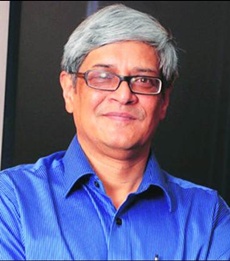PM’s economic adviser Debroy questions Railways’ all-electric push
15 Feb 2018
Chairman of the Prime Minister's Economic Advisory Council Bibek Debroy has called for a rethink on the government's plans to electrify the entire Indian Railways network, doing away with diesel engines.
 | |
| Bibek Debroy |
In a report titled Mission 100% Railway Electrification: Need for a Strategic Re-think? the government's senior economist says there is limited clarity on returns on an estimated capital investment of Rs1 lakh crore on the electrification exercise.
''Hence it is strongly suggested that the government take a step back at this stage and get this issue examined by expert group in a comprehensive manner,'' Debroy has said in a detailed analysis which has reached Rail Bhavan via the Prime Minister's Office, reports The Indian Express.
''Future course of action, in terms of speed of execution and levels of electrification envisaged, should be guided by findings of this study. A time of five to six months should be given for this study,'' the paper states.
Asked for comment, Debroy declined, saying, ''I would not like to comment on it.''
The Railways' total electrification drive and talk of phasing out diesel completely stem from a power ministry policy proposal two years ago, when Piyush Goyal, now the railways minister, was the power minister then. The plan is to make a concerted push for 100-per cent conversion to electric traction. Electrification of diesel routes on the railways is a key policy initiative of the government, which found mention in this year's Union Budget.
The railways hopes to save Rs10,000 crore a year on fuel bills, but Debroy's paper questions this analysis and calls for further examination.
The note has quoted government data as well as reports commissioned by governments in the past to question the feasibility of electrification and sought views from ''stakeholders'' to get a comprehensive picture.
However, Debroy's report says that till the time that the suggested study takes place and the Railways finally decides on a traction policy, the ongoing electrification should not be slowed down, because electrification levels in India are still sub-optimal.
''Since Indian Railways has access to limited funds, it may take a judicious call on whether electrification needs substantial hike in funding immediately or it is better off in putting money into avenues which need priority investments (safety works, network decongestion, expansion works, modernisation etc),'' the paper states.
Analysing arguments for and against electrification recorded in reports in the past and putting in context the available financial numbers, the paper leans towards continuing a dual traction policy of electric and diesel.
Presenting data of railway systems from other countries, the analysis has taken note that China, Russia and Europe have between 33 and 43 per cent diesel traction in their railways. In North America and Latin America, 99 per cent of the trains run on diesel. In India it is 50 per cent. Globally, the railway systems (India included) have a mix of traction wherein 45 per cent locomotives are run on electric while the majority are on diesel.
''It is also suggested that Indian Railways puts in place a rolling stock strategy,'' the paper states.
The future traction strategy, according to the paper, should consider aspects like gradual phase-out path of less efficient and lower horse power diesel and electric locomotives with modern state-of-the-art products; impact of train sets on future requirement of diesel and electric locomotives in passenger business, etc.
The analysis estimates that the capital cost of electrification of around 40,000 km of lines, replacing around 5,000 diesel engines with electric ones together, would be around Rs 1lakh crore when taken together with depreciation cost and the debt service obligation over the next four-five years - funds for which Railways would have to tap market sources.
In terms of financial feasibility of total electrification, the paper puts forth arguments that question the official calculation that conversion to a total electric fleet will save the Railways Rs 10,000 crore on fuel bills annually.
''If one considers the fact that taxes (state and union combined) account for more than 50 per cent of diesel cost, the net savings to the government look more reasonably to be around Rs5,000 crore per annum rather than Rs10,000 crore,'' it says, adding, ''Information in public domain shows that diesel and electric traction have similar levels of operating cost (per unit).''
The paper from Debroy also rues that there is lack of any credible study that ''details the financial computation for the mission electrification''. To present arguments on utility of having two kinds of fuel systems, the paper touches upon the rationale of strategic flexibility that diesel engines offer, especially in cases of crisis, disasters, war, etc.
''Any rethink on the need, viability, appropriateness or the implementation speed in the mid-term would be difficult and costly,'' the note says, adding, ''Considering the size, scale and strategic implications of this decision, it is therefore crucial to take a step back and examine carefully the pros and cons of this mission. At the least, the major concerns should be examined dispassionately to ensure that the path towards mission electrification is based on a firm foundation.''






















